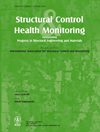Integral resonant control scheme for cancelling human-induced vibrations in light-weight pedestrian structures
SUMMARY
Integral resonant control (IRC) has been recently introduced as a simple, robust and high-performance technique for vibration control of smart structures instrumented with collocated piezoelectric actuator–sensor pairs. This work deals with the design and implementation of an active vibration control (AVC) system based on an IRC strategy for the mitigation of human-induced vibrations in light-weight civil engineering structures, such as floors and footbridges, via proof-mass actuators. This work presents a new AVC strategy that combines an approximate inversion of the proof-mass actuator dynamics with an IRC-based strategy. The result is a control scheme with the following desirable characteristics: (i) the closed-loop system exhibits very high stability margins, (ii) the risk of stroke saturation at low frequencies is significantly reduced so that the saturation nonlinearity, which has to be included to keep the system hardware safe, can be designed to account only for force saturation (i.e. the actuator performance is enhanced), (iii) rigorous stability analysis and systematic design can be proposed and (iv) it is not necessary to measure the actuator force. The stability analysis is carried out using the recently developed stability theorem based on the positive feedback interconnection of systems with negative imaginary frequency response. The control scheme is validated on a full-scale prestressed concrete laboratory structure. Excellent vibration reduction performance is reported for frequency-response-function-based tests and for walking excitations. Copyright © 2010 John Wiley & Sons, Ltd.




